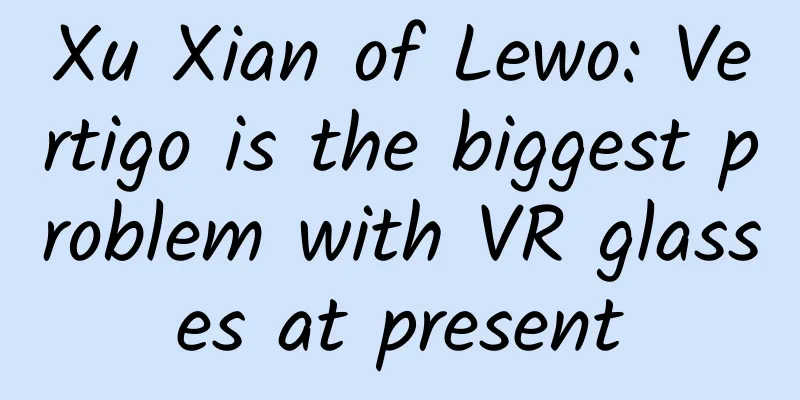Xu Xian of Lewo: Vertigo is the biggest problem with VR glasses at present

|
According to the news, iQIYI VR Summit was successfully held in Shangfang Garden on the afternoon of July 26. A special report was conducted on this event. At the summit, Lewo CEO Xu Xian delivered a speech, pointing out that dizziness is the biggest problem with head-mounted glasses at present, and briefly analyzed the pros and cons of various mainstream display solutions from a technical perspective. At the same time, he revealed Lewo's all-in-one plan. The following is a transcript of Xu Xian’s speech: Thank you Mr. Duan and the above for organizing the meeting. The scene was very hot. Everyone is very interested in forming a VR circle and wants to do something in the VR circle. I am a hardware company, so I will talk about the old foundation. What should VR do next? Although the imagination space is very good and very large, now, including domestic and foreign products, they cannot be considered as consumer products in the true sense. There are still many limitations in hardware. Do we have the opportunity to use better technology to make the hardware more perfect, to make the hardware more refined, less, and more comfortable to wear. I have tried VR products for many people, and I have also met many people who don’t want to eat for half a day after ten minutes. Of course, it is also related to the physical constitution of the person himself. I think the limitations of the hardware experience are gradually becoming more and more serious, and may become a stumbling block that affects the further improvement of the VR experience. This is the hardware distribution of VR products counted by a foreign consulting agency. There are mainly two types of products in the world, including in China. One is for mobile phones, and the other is integrated VR products. These are the more representative products. The common problem is that it is heavy. Girls with small faces can only see their mouths after wearing VR. In addition, they feel dizzy. After wearing it, not to mention other interactive aspects, after wearing it, very few people who have never experienced VR can endure it for ten or fifteen minutes. Is there a way, from the industry, from the world's latest technology, is there a way to make it as light, beautiful, and free of visual fatigue as the picture on the right? Below I will share with you some of my latest experiences in the industry. In fact, the most important factor affecting the VR experience now is the display or the design of the optical system. In fact, Mr. Chen’s Dapeng now uses a 5.5-inch LCD screen. Basically, the size and volume determine that Lexiang cannot be made small. Is there any new technology that can subvert the existing compromise display solution in the near future, in one or two years? Below are some of the more mainstream optical solutions, including those that have been on the market, in mass production, or in the laboratory. Some prototypes or some samples can be analyzed one by one. The first is the Oculus optical system, the most economical and cheapest. The industry calls it a direct-level system or sandwich system. Your screen lens and eyes only have three layers. The biggest advantage is that it is easier to set up and relatively cheap. Its disadvantage is that the aberration formed by the lens alone is very large. The edge changes and colors need to be corrected by software to restore the picture to normal. Basically, it can be said that 95% of the products currently use this optical amplifier, and it can be said that 100% of domestic products use this solution. The second one is HTC-VIve. The lens of this product is made relatively thin, but the problem is that there may be some stray light, which will affect the image quality. The third one is Razor-OSVR. Unlike the previous two, it uses a double-layer lens. The best benefit is that the image quality does not need to be corrected by software at 90 degrees, which is good for the burden on the system software. However, its disadvantage is that two layers of lenses need to be designed, which will have a certain impact in terms of cost and weight. The above three are basically made by rotating through a 5.5-inch screen. The next one is relatively new, which is Emagin, which makes its own Oculus display. Its optical solution is a polarization return system, which basically uses the polarization characteristics and the splitting ability of the polarization beam splitter. Although this product is only a very prototype product, it inspires us that in the near future we have a great opportunity to make very small and very convenient glasses. This is a projection reflection system. The V-type projector corrects and then derives and re-images through reflection. I guess Microsoft may use similar technology. One advantage is that the viewing angle is relatively large, 80 to 120, and the reflection situation is large enough. Second, it can reduce the current eye pressure, making things look more natural and more comfortable. Some companies are researching, but they are restricted by various problems such as the molding and mass production of curved reflective surfaces. The setup will be relatively complicated. This is the result of a study released by NVidia in 2013. For near-eye light field displays, the lenses have many lens arrays combined together to form an image. From the middle picture, you can see that the thickness is very thin. There is a chance that in the future, for example, it can be made as thick as ordinary sunglasses, with a viewing angle of only 40 degrees. Because of the lens array, the processing is very difficult and the resolution cannot be achieved. Of course, it gives us an idea. Is there a different display solution or a different optical solution to subvert the current similar-looking products? Can we make better designs in them? This is a rough summary of the advantages and disadvantages of various display solutions. If we look at the projection display market in two or five years, it is possible that one or more of the following solutions will emerge and become the mainstream solution. Let me talk about dizziness. Dizziness is also the biggest problem of head-mounted glasses at present. Of course, there are many reasons for dizziness, including optical problems, lens design problems or problems of being too close or too far. Here I will focus on the delay system, because the optical problem itself is relatively simple. The left picture is the delay part of the entire head-mounted display system. It was more than 50 seconds before and more than 30 seconds later. Oculus believes that people will be more likely to accept it if it is 20 milliseconds or less, and the feeling of dizziness will be much better. There are three points about dizziness. The first point is head tracking. From hardware sensors and your data fusion algorithm, you can play a higher performance. The general data rate of mobile phones is between 50 Hz and 100 Hz. If the current mobile phone box solution does not do any underlying optimization, it will take 10 milliseconds just from the head tracking. So I have always believed that it is difficult to do a good mobile phone box experience, because dizziness cannot be controlled at all. The second is to optimize the underlying software or the optimization of the entire market. The third is the choice of display solution. Why did Dapeng use Oculus? It is also to show that there are more different ways to reduce the delay as much as possible. Let me briefly talk about head tracking. Many developers may only focus on sensors, but often ignore the importance of the geomagnetic sensor. In fact, it is very important in this algorithm. As we all know, it has drift, and errors will occur over time and space. Geomagnetism will correct this very well. There is also your data sampling rate, which is not only the sampling rate of your chip, but the sampling rate of your data after data fusion. This is the most important. In fact, many companies say that there is 1K Hz (English), but there is still some consideration here, and there is still a question mark. This is a software optimization process. For example, it is the algorithm of Oculus in Samsung. The figure below is the result of our engineer's test. If it is used, this method will indeed have a very obvious effect on the system's response or delay. Next, let me talk about the delay caused by the display. Actually, Mr. Chen also said just now, why does he use OLE? He gave many reasons. Its biggest advantage is that OLED has a very short build time. Ordinary LCD takes 20 milliseconds from full white to full black and then to full white, while OLED can be controlled within 3 milliseconds. Is OLED really that good? In fact, there are also obvious shortcomings, because OLED has a lot of black edges in the middle of the pixel arrangement, so why does the OLED screen look a little coarser than the LCD screen on the same resolution and the same optical system? The exquisiteness of the picture is better than that of OLED. Can we combine these two advantages together? It is possible that DMD may be a good direction, because it uses (English) technology, so it can refresh thousands of times per second in terms of refresh rate. This refresh rate is not a problem. The current maximum refresh rate can reach 120 Hz. Secondly, its contrast is better, with a contrast ratio of 2000:1. The pixel arrangement is better than LCD. The exquisiteness of the display under the lens should also be better than the above two solutions, but it is limited by DMD. It may be that the system design is more complicated, and fewer companies have tried this work. Let me briefly introduce what products Lewo Technology makes. We make head-mounted hardware and 360-degree panoramic solutions. This is our product, and it is also a product made with mobile phones, with content platforms and 360-degree video players. This is our all-in-one plan. This is based on a mobile platform. It is a complete system with a TV that can work independently, with a fully accessible interactive experience. This is one of our 360-degree panoramic shots, shot with a professional camera, reaching broadcast or movie-level shooting technology. Currently, we can do 360-degree video live broadcasting. In shooting, splicing, encoding and playback, including Android and IOS, are all supported by our software. Thank you! As a winner of Toutiao's Qingyun Plan and Baijiahao's Bai+ Plan, the 2019 Baidu Digital Author of the Year, the Baijiahao's Most Popular Author in the Technology Field, the 2019 Sogou Technology and Culture Author, and the 2021 Baijiahao Quarterly Influential Creator, he has won many awards, including the 2013 Sohu Best Industry Media Person, the 2015 China New Media Entrepreneurship Competition Beijing Third Place, the 2015 Guangmang Experience Award, the 2015 China New Media Entrepreneurship Competition Finals Third Place, and the 2018 Baidu Dynamic Annual Powerful Celebrity. |
<<: JAMA: 2017 Japanese Passenger Car Market Trend Survey Report
Recommend
NetEase Designer: How to design a banner that can make users pay?
We explore this in three dimensions: Data-driven ...
In addition to Alipay's five blessings, there are billions more! A complete guide to picking up money from the Spring Festival red envelopes
[[380950]] In the past two days, I believe everyo...
New version of fake voice fake voice tutorial video tutorial Daquan male fake female fake male voice actor dubbing online course zero basic tutorial Baidu cloud download
New version of fake voice fake voice tutorial vid...
Zuckerberg Q&A: Why do you force us to install Facebook Messenger?
[[122386]] Although FB holds Q&A events for t...
Methods for attracting new users through event operations!
In recent years, I have seen many user operations...
Have you ever used the black technology code? The god-like automatic code app
When we share screenshots, we usually block out o...
After more than ten years, the Three Gorges Dam is still as solid as new. What’s the secret?
What is the largest hydroelectric project in the ...
The third issue of Wanquan Baidu screen dominance fast ranking, quickly obtain ranking traffic
SEO fast ranking technology Wanquan: Baidu SEO fa...
Dealing with two common problems in iOS development
[[134199]] (I) “Unknown class XXViewController in...
Is Maiqiu'er's explanation of the residue reliable?
In response to the milk quality issue that has at...
It is just wishful thinking that domestic mobile phones can compete with Apple and Samsung
In the past 2014, in the smartphone industry, the...
Latest research: People who skip breakfast have a greatly increased risk of developing these 6 diseases
Researchers from the Run Run Shaw Hospital affili...
Can umbilical cord blood save lives at a critical moment? Is there any scientific basis for the saying "give birth to one and save one"?
Following the success of "The World", &...
Taking on alpine skiing? Wind tunnel 3D modeling to help
Light a cigarette, the wind starts to blow. In th...
The second half of search: Will WeChat do big search?
[[378650]] In the just-concluded WeChat 2021 Open...









